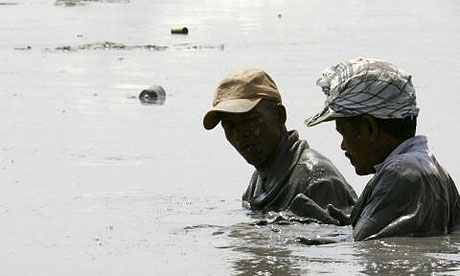Indonesia mud volcano caused by gas well drilling
By Ian MacKinnon, South-east Asia correspondent, guardian.co.uk, Monday November 03 2008 15.24 GMT
Two residents of Sidoarjo in eastern Java wade through chest-deep mud in search of possessions lost to the mud volcano. Photograph: Dimas Ardian/Getty Images
Tens of thousands of Indonesian villagers battling for compensation after a mud volcano swamped their homes have received a boost after a panel of international scientists concluded that exploratory drilling for gas had caused the eruption.
Leading geologists assessing the flow of toxic mud that has continued for more than two years overwhelmingly concluded that the drilling of a gas well by the energy company Lapindo Brantas was responsible.
Scientists for the company, which is indirectly owned by the family of Indonesia's social welfare minister, Aburizal Bakrie, argued the data showed that an earthquake two days earlier in Yogyakarta, 280kms (174 miles) away, was the cause.
But at a conference of 74 independent petroleum geologists in Cape Town, South Africa, only three backed the company while 42 of the scientists agreed the fresh evidence revealed the drilling was the cause.
The company has already been ordered by the government to pay £255m in interim compensation, but a police investigation is continuing to establish the source of the eruption that spews the equivalent of 53 Olympic swimming pools of mud daily.
In all, 36,000 people near the site in Sidoarjo, eastern Java, were displaced by the mudflow that also has inundated 12 factories and two villages, and threatens another ten.
All efforts to stem the flow that began in May 2006 have failed, including one attempt that involved dropping huge concrete spheres into the volcano's mouth.
Dykes of earth 15m high were built to contain the bubbling sludge that now covers 640 hectares - equivalent to around 600 football pitches. Scientists fear the eruption could continue for decades.
At the American Association of Petroleum Geologists meeting last week, experts for both sides of the battle to establish liability put their cases for the first time. New figures revealing pressure levels in the exploration well for the 24 hours leading up to the eruption of the volcano - known locally as Lusi - were released for the first time.
Professor Richard Davies of Durham University, one of the world's foremost experts on mud volcanoes, argued the readings pointed to a pressure build-up that caused fractures sparked by the nearby borehole.
Claims by experts from the Indonesian drilling company that the 6.3 magnitude earthquake earlier had led to the fracture were dismissed. Other scientists said it was not sufficiently strong and too distant to cause the eruption.
Prof Davies said: "I remain convinced that drilling was the cause of the mud volcano. The opinion of the international scientists ... adds further weight to my conviction and the conclusions of many other leading scientists who have studied Lusi."











No comments:
Post a Comment